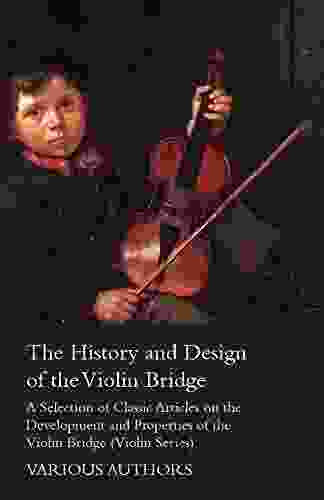The History and Design of the Violin Bridge: A Selection of Classic Articles

The violin bridge is a small but essential component of the violin that plays a crucial role in the instrument's sound and playability. It is responsible for transmitting the vibrations of the strings to the body of the violin, which then produces the characteristic resonant sound that is so distinctive to the instrument.
4 out of 5
| Language | : | English |
| File size | : | 564 KB |
| Text-to-Speech | : | Enabled |
| Screen Reader | : | Supported |
| Enhanced typesetting | : | Enabled |
| Print length | : | 34 pages |
The history of the violin bridge can be traced back to the early days of the instrument's development in the 16th century. The earliest bridges were simple wooden structures that were carved from a single piece of wood. Over time, the bridge evolved in design, with the addition of a separate soundpost and the use of different materials, such as ebony and ivory.
Today, the violin bridge is typically made from a single piece of hardwood, such as ebony or maple. It is carefully shaped and fitted to the violin, and its position and height can be adjusted to achieve the best possible sound and playability.
The design of the violin bridge is a complex and delicate process. The bridge must be strong enough to support the tension of the strings, but it must also be light enough to allow the strings to vibrate freely. The shape of the bridge also affects the sound of the violin, with a higher bridge producing a brighter sound and a lower bridge producing a darker sound.
The violin bridge is a vital component of the instrument, and its design and construction can have a significant impact on the sound and playability of the violin. In this article, we will explore the history and design of the violin bridge, and we will provide a selection of classic articles that offer insights into this essential component.
The History of the Violin Bridge
The violin bridge is one of the most important components of the violin. It is responsible for transmitting the vibrations of the strings to the body of the violin, which then produces the characteristic resonant sound that is so distinctive to the instrument.
The earliest violin bridges were simple wooden structures that were carved from a single piece of wood. These bridges were often quite crude, and they did not always produce the best possible sound. Over time, the bridge evolved in design, with the addition of a separate soundpost and the use of different materials, such as ebony and ivory.
The modern violin bridge is a complex and delicate structure. It is typically made from a single piece of hardwood, such as ebony or maple. The bridge is carefully shaped and fitted to the violin, and its position and height can be adjusted to achieve the best possible sound and playability.
The Design of the Violin Bridge
The design of the violin bridge is a complex and delicate process. The bridge must be strong enough to support the tension of the strings, but it must also be light enough to allow the strings to vibrate freely. The shape of the bridge also affects the sound of the violin, with a higher bridge producing a brighter sound and a lower bridge producing a darker sound.
The bridge is typically made from a single piece of hardwood, such as ebony or maple. The bridge is carefully shaped and fitted to the violin, and its position and height can be adjusted to achieve the best possible sound and playability.
The bridge is composed of several parts, including the feet, the crown, and the wings. The feet of the bridge rest on the soundboard of the violin, and they are responsible for transmitting the vibrations of the strings to the body of the instrument. The crown of the bridge is the highest point of the bridge, and it is responsible for supporting the strings. The wings of the bridge are located on either side of the crown, and they help to stabilize the bridge and prevent it from collapsing.
The design of the violin bridge has been refined over centuries, and it is now a highly evolved structure that is essential for the production of the violin's characteristic sound.
Classic Articles on the Violin Bridge
There are a number of classic articles that have been written about the violin bridge. These articles offer insights into the history, design, and construction of the bridge, and they provide valuable information for violin makers and players alike.
Here is a selection of classic articles on the violin bridge:
- "The Violin Bridge" by George Fry (1880)
- "The Design of the Violin Bridge" by Frederick Hamma (1930)
- "The Construction of the Violin Bridge" by Henry Strobel (19
4 out of 5
| Language | : | English |
| File size | : | 564 KB |
| Text-to-Speech | : | Enabled |
| Screen Reader | : | Supported |
| Enhanced typesetting | : | Enabled |
| Print length | : | 34 pages |
Do you want to contribute by writing guest posts on this blog?
Please contact us and send us a resume of previous articles that you have written.
 Top Book
Top Book Novel
Novel Fiction
Fiction Nonfiction
Nonfiction Literature
Literature Paperback
Paperback Hardcover
Hardcover E-book
E-book Audiobook
Audiobook Bestseller
Bestseller Classic
Classic Mystery
Mystery Thriller
Thriller Romance
Romance Fantasy
Fantasy Science Fiction
Science Fiction Biography
Biography Memoir
Memoir Autobiography
Autobiography Poetry
Poetry Drama
Drama Historical Fiction
Historical Fiction Self-help
Self-help Young Adult
Young Adult Childrens Books
Childrens Books Graphic Novel
Graphic Novel Anthology
Anthology Series
Series Encyclopedia
Encyclopedia Reference
Reference Guidebook
Guidebook Textbook
Textbook Workbook
Workbook Journal
Journal Diary
Diary Manuscript
Manuscript Folio
Folio Pulp Fiction
Pulp Fiction Short Stories
Short Stories Fairy Tales
Fairy Tales Fables
Fables Mythology
Mythology Philosophy
Philosophy Religion
Religion Spirituality
Spirituality Essays
Essays Critique
Critique Commentary
Commentary Glossary
Glossary Bibliography
Bibliography Index
Index Table of Contents
Table of Contents Preface
Preface Introduction
Introduction Foreword
Foreword Afterword
Afterword Appendices
Appendices Annotations
Annotations Footnotes
Footnotes Epilogue
Epilogue Prologue
Prologue Suzanne Brockmann
Suzanne Brockmann Cindy Higham
Cindy Higham Aric Davis
Aric Davis Nicholas Eames
Nicholas Eames Kei Sasuga
Kei Sasuga Mrunal Deo
Mrunal Deo Mark Jacob
Mark Jacob Ken Green
Ken Green Grant Pickup
Grant Pickup Ryuto
Ryuto Margaret Frazer
Margaret Frazer G Jason Goddard
G Jason Goddard Walker Abel
Walker Abel Thomas Temple
Thomas Temple Frater R C
Frater R C Vera Oliveira
Vera Oliveira Luigi Stecco
Luigi Stecco Nikki St Crowe
Nikki St Crowe Kevin Wignall
Kevin Wignall Samantha Dion Baker
Samantha Dion Baker
Light bulbAdvertise smarter! Our strategic ad space ensures maximum exposure. Reserve your spot today!

 Fletcher MitchellIntegration and Infusion in Practice: International Race and Education Series
Fletcher MitchellIntegration and Infusion in Practice: International Race and Education Series
 Miguel de CervantesNeapolitan Medley Vesuvian Hits Medley for Flute Quartet: A Musical Journey...
Miguel de CervantesNeapolitan Medley Vesuvian Hits Medley for Flute Quartet: A Musical Journey... Orson Scott CardFollow ·8.6k
Orson Scott CardFollow ·8.6k Richard SimmonsFollow ·5.9k
Richard SimmonsFollow ·5.9k Colin RichardsonFollow ·19k
Colin RichardsonFollow ·19k Neil GaimanFollow ·7.6k
Neil GaimanFollow ·7.6k Yasunari KawabataFollow ·5.7k
Yasunari KawabataFollow ·5.7k Louis HayesFollow ·5.7k
Louis HayesFollow ·5.7k Alexander BlairFollow ·3.2k
Alexander BlairFollow ·3.2k Junot DíazFollow ·11.2k
Junot DíazFollow ·11.2k

 Joseph Conrad
Joseph ConradExport Now: Five Keys to Entering New Markets
Are you looking to expand your business into...
 Christopher Woods
Christopher WoodsElvis Presley: The King of Rock and Roll and an Icon of...
Elvis Presley was an...

 Kelly Blair
Kelly BlairData-Driven Leadership: A Comprehensive Guide for...
In today's rapidly changing educational...

 Joe Simmons
Joe Simmons37 Stories of Canine Companionship and Courage
Dogs have been our...

 Martin Cox
Martin CoxChilling Psychological Thriller With Twist: Brace...
Prepare yourself for...
4 out of 5
| Language | : | English |
| File size | : | 564 KB |
| Text-to-Speech | : | Enabled |
| Screen Reader | : | Supported |
| Enhanced typesetting | : | Enabled |
| Print length | : | 34 pages |










